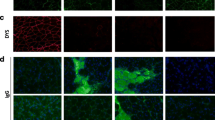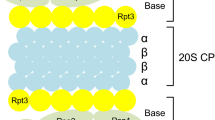Abstract
Increased proteasome activity has been implicated in the atrophy and deterioration associated with dystrophic muscles of Duchenne muscular dystrophy (DMD). While proteasome inhibitors show promise in the attenuation of muscle degeneration, proteasome inhibition-induced toxicity was a major drawback of this therapeutic strategy. Inhibitors that selectively target the proteasome subtype that is responsible for the loss in muscle mass and quality would reduce side effects and be less toxic. This study examined proteasome activity and subtype populations, along with muscle function, morphology and damage in wild-type (WT) mice and two murine models of DMD, dystrophin-deficient (MDX) and dystrophin- and utrophin-double-knockout (DKO) mice. We found that immunoproteasome content was increased in dystrophic muscles while the total proteasome content was unchanged among the three genotypes of mice. Proteasome proteolytic activity was elevated in dystrophic muscles, especially in DKO mice. These mice also exhibited more severe muscle atrophy than either WT or MDX mice. Muscle damage and regeneration, characterized by the activity of muscle creatine kinase in the blood and the percentage of central nuclei were equally increased in dystrophic mice. Accordingly, the overall muscle function was similarly reduced in both dystrophic mice compared with WT. These data demonstrated that there was transformation of standard proteasomes to immunoproteasomes in dystrophic muscles. In addition, DKO that showed greatest increase in proteasome activities also demonstrated more severe atrophy compared with MDX and WT. These results suggest a putative role for the immunoproteasome in muscle deterioration associated with DMD and provide a potential target for therapeutic intervention.








Similar content being viewed by others
References
Assereto S, Stringara S, Sotgia F, Bonuccelli G, Broccolini A, Pedemonte M, Traverso M, Biancheri R, Zara F, Bruno C, Lisanti MP, Minetti C (2006) Pharmacological rescue of the dystrophin-glycoprotein complex in Duchenne and Becker skeletal muscle explants by proteasome inhibitor treatment. Am J Physiol Cell Physiol 290(2):C577–C582. doi:10.1152/ajpcell.00434.2005
Bonuccelli G, Sotgia F, Schubert W, Park DS, Frank PG, Woodman SE, Insabato L, Cammer M, Minetti C, Lisanti MP (2003) Proteasome inhibitor (MG-132) treatment of mdx mice rescues the expression and membrane localization of dystrophin and dystrophin-associated proteins. Am J Pathol 163(4):1663–1675. doi:10.1016/s0002-9440(10)63523-7
Bonuccelli G, Sotgia F, Capozza F, Gazzerro E, Minetti C, Lisanti MP (2007) Localized treatment with a novel FDA-approved proteasome inhibitor blocks the degradation of dystrophin and dystrophin-associated proteins in mdx mice. Cell Cycle 6(10):1242–1248
Briguet A, Erb M, Courdier-Fruh I, Barzaghi P, Santos G, Herzner H, Lescop C, Siendt H, Henneboehle M, Weyermann P, Magyar JP, Dubach-Powell J, Metz G, Meier T (2008) Effect of calpain and proteasome inhibition on Ca2+ -dependent proteolysis and muscle histopathology in the mdx mouse. FASEB J 22(12):4190–4200. doi:10.1096/fj.07-099036
Buetler TM, Renard M, Offord EA, Schneider H, Ruegg UT (2002) Green tea extract decreases muscle necrosis in mdx mice and protects against reactive oxygen species. Am J Clin Nutr 75(4):749–753
Cole MA, Rafael JA, Taylor DJ, Lodi R, Davies KE, Styles P (2002) A quantitative study of bioenergetics in skeletal muscle lacking utrophin and dystrophin. Neuromuscul Disord 12(3):247–257
Dangain J, Vrbova G (1984) Muscle development in mdx mutant mice. Muscle Nerve 7(9):700–704. doi:10.1002/mus.880070903
Davies KE, Nowak KJ (2006) Molecular mechanisms of muscular dystrophies: old and new players. Nat Rev Mol Cell Biol 7(10):762–773. doi:10.1038/nrm2024
Deconinck AE, Rafael JA, Skinner JA, Brown SC, Potter AC, Metzinger L, Watt DJ, Dickson JG, Tinsley JM, Davies KE (1997) Utrophin-dystrophin-deficient mice as a model for Duchenne muscular dystrophy. Cell 90(4):717–727
Deshaies RJ, Joazeiro CA (2009) RING domain E3 ubiquitin ligases. Annu Rev Biochem 78:399–434. doi:10.1146/annurev.biochem.78.101807.093809
Ethen CM, Hussong SA, Reilly C, Feng X, Olsen TW, Ferrington DA (2007) Transformation of the proteasome with age-related macular degeneration. FEBS Lett 581(5):885–890. doi:10.1016/j.febslet.2007.01.061
Ferrington DA, Gregerson DS (2012) Immunoproteasomes: structure, function, and antigen presentation. Prog Mol Biol Transl Sci 109:75–112. doi:10.1016/b978-0-12-397863-9.00003-1
Ferrington DA, Husom AD, Thompson LV (2005) Altered proteasome structure, function, and oxidation in aged muscle. FASEB J 19(6):644–646
Gazzerro E, Assereto S, Bonetto A, Sotgia F, Scarfi S, Pistorio A, Bonuccelli G, Cilli M, Bruno C, Zara F, Lisanti MP, Minetti C (2010) Therapeutic potential of proteasome inhibition in Duchenne and Becker muscular dystrophies. Am J Pathol 176(4):1863–1877. doi:10.2353/ajpath.2010.090468
Glass DJ (2010) Signaling pathways perturbing muscle mass. Curr Opin Clin Nutr Metab Care 13(3):225–229
Graber TG, Ferguson-Stegall L, Kim JH, Thompson LV (2013) C57BL/6 Neuromuscular Healthspan Scoring System. J Gerontol A Biol Sci Med Sci 68(11):1326–1336
Grady RM, Teng H, Nichol MC, Cunningham JC, Wilkinson RS, Sanes JR (1997) Skeletal and cardiac myopathies in mice lacking utrophin and dystrophin: a model for Duchenne muscular dystrophy. Cell 90(4):729–738
Hollinger K, Selsby JT (2013) The physiological response of protease inhibition in dystrophic muscle. Acta Physiol (Oxf). doi:10.1111/apha.12114
Husom AD, Peters EA, Kolling EA, Fugere NA, Thompson LV, Ferrington DA (2004) Altered proteasome function and subunit composition in aged muscle. Arch Biochem Biophys 421(1):67–76
Hussong SA, Kapphahn RJ, Phillips SL, Maldonado M, Ferrington DA (2010) Immunoproteasome deficiency alters retinal proteasome’s response to stress. J Neurochem 113(6):1481–1490. doi:10.1111/j.1471-4159.2010.06688.x
Kohler M, Clarenbach CF, Bahler C, Brack T, Russi EW, Bloch KE (2009) Disability and survival in Duchenne muscular dystrophy. J Neurol Neurosurg Psychiatry 80(3):320–325. doi:10.1136/jnnp.2007.141721
Kotamraju S, Matalon S, Matsunaga T, Shang T, Hickman-Davis JM, Kalyanaraman B (2006) Upregulation of immunoproteasomes by nitric oxide: potential antioxidative mechanism in endothelial cells. Free Radic Biol Med 40(6):1034–1044. doi:10.1016/j.freeradbiomed.2005.10.052
Kruger E, Kloetzel PM (2012) Immunoproteasomes at the interface of innate and adaptive immune responses: two faces of one enzyme. Curr Opin Immunol 24(1):77–83. doi:10.1016/j.coi.2012.01.005
Kumamoto T, Fujimoto S, Ito T, Horinouchi H, Ueyama H, Tsuda T (2000) Proteasome expression in the skeletal muscles of patients with muscular dystrophy. Acta Neuropathol 100(6):595–602
Mahowald ML, Krug H, Taurog J (1988) Progressive ankylosis in mice. An animal model of spondylarthropathy. I. Clinical and radiographic findings. Arthritis Rheum 31(11):1390–1399
Mizushima N, Yoshimori T (2007) How to interpret LC3 immunoblotting. Autophagy. 3(6):542–545
Niebroj-Dobosz I, Hausmanowa-Petrusewicz I (2005) The involvement of oxidative stress in determining the severity and progress of pathological processes in dystrophin-deficient muscles. Acta Biochim Pol 52(2):449–452
Passamano L, Taglia A, Palladino A, Viggiano E, D’Ambrosio P, Scutifero M, Rosaria Cecio M, Torre V, DE Luca F, Picillo E, Paciello O, Piluso G, Nigro G, Politano L (2012) Improvement of survival in Duchenne muscular dystrophy: retrospective analysis of 835 patients. Acta myol 31(2):121–125
Perkins KJ, Davies KE (2002) The role of utrophin in the potential therapy of Duchenne muscular dystrophy. Neuromuscul Disord 12(Suppl 1):S78–S89
Rafael JA, Townsend ER, Squire SE, Potter AC, Chamberlain JS, Davies KE (2000) Dystrophin and utrophin influence fiber type composition and post-synaptic membrane structure. Hum Mol Genet 9(9):1357–1367
Sandri M (2010) Autophagy in skeletal muscle. FEBS Lett 584(7):1411–1416
Seifert U, Bialy LP, Ebstein F, Bech-Otschir D, Voigt A, Schroter F, Prozorovski T, Lange N, Steffen J, Rieger M, Kuckelkorn U, Aktas O, Kloetzel PM, Kruger E (2010) Immunoproteasomes preserve protein homeostasis upon interferon-induced oxidative stress. Cell 142(4):613–624. doi:10.1016/j.cell.2010.07.036
Selsby J, Pendrak K, Zadel M, Tian Z, Pham J, Carver T, Acosta P, Barton E, Sweeney HL (2010) Leupeptin-based inhibitors do not improve the mdx phenotype. Am J Physiol Regul Integr Comp Physiol 299(5):R1192–R1201. doi:10.1152/ajpregu.00586.2009
Tidball JG, Wehling-Henricks M (2007) The role of free radicals in the pathophysiology of muscular dystrophy. J Appl Physiol 102(4):1677–1686. doi:10.1152/japplphysiol.01145.2006
Whitehead NP, Pham C, Gervasio OL, Allen DG (2008) N-Acetylcysteine ameliorates skeletal muscle pathophysiology in mdx mice. J Physiol 586(7):2003–2014. doi:10.1113/jphysiol.2007.148338
Zu L, Bedja D, Fox-Talbot K, Gabrielson KL, Van Kaer L, Becker LC, Cai ZP (2010) Evidence for a role of immunoproteasomes in regulating cardiac muscle mass in diabetic mice. J Mol Cell Cardiol 49(1):5–15. doi:10.1016/j.yjmcc.2010.02.007
Acknowledgments
This project was funded in part by Gregory Marzolf Jr. Muscular Dystrophy Training Grant from Paul and Sheila Wellstone Muscular Dystrophy Center, University of Minnesota, the Department of Ophthalmology and Visual Neurosciences, University of Minnesota, NIH T32 (T32-AG029796), NIH F31 (F31-AG044108) and NIH R01 (R01-AG017768-10).
Author information
Authors and Affiliations
Corresponding author
Rights and permissions
About this article
Cite this article
Chen, Cn.J., Graber, T.G., Bratten, W.M. et al. Immunoproteasome in animal models of Duchenne muscular dystrophy. J Muscle Res Cell Motil 35, 191–201 (2014). https://doi.org/10.1007/s10974-014-9385-x
Received:
Accepted:
Published:
Issue Date:
DOI: https://doi.org/10.1007/s10974-014-9385-x




